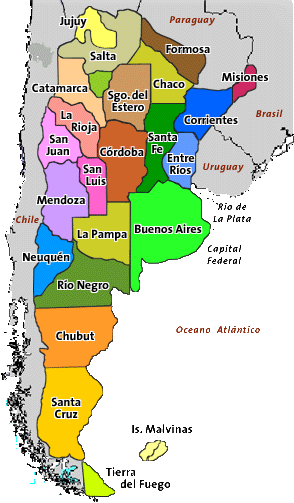Argentina Wine Regions

Argentina has been producing wine since the mid 16th century. The vines were brought by Spanish settlers and the Argentina wine regions were soon established along the foots of the Andes. The difficulty of getting the wines to the population on the east didn't help in the development of the industry, and it wasn't until the end of the 19th century that the Argentine wine market truly began. Then came times of economic and social crisis. Exportations were low and the country's economy couldn't sustain the production of high quality wines for self consumption, so most of the wines were table wines. When the trade borders opened at the beginning of the 20th century, Argentina's wine industry started to develop at a rapid pace and soon made a name for itself.
The climate in most of the Argentina wine regions is semi-arid and desert-like, with very little rainfall. The warmest regions (San Juan, La Rioja, Catamarca...) can reach daytime temperature of over 40ºC, with nighttime temperatures dropping as far as 10ºC. Climate around Mendoza or Salta are more temperate, and the temperatures in general are lower. Nighttime temperatures can go as low as 0ºC, although frosts are rare. Most of the rainfall takes place during the summer, and the late summer months sometimes see storms of hail that destroy part of the vineyards.
Argentina Wine Regions
From north to south there are two strong wine making regions (Mendoza and San Juan) and a developing one with different sub areas (La Rioja, Catamarca, Alta...). There are also some vineyards in the eastern part of the country, in the provinces of Cordoba, Buenos Aires and La Pampa, but their production is quite scarce.
The most popular grape in the Argentina wine regions is the Malbec, a French variety brought to the country by the French agronomist Miguel Aimé Pouget in the 16th century. The conditions in Argentina suit the Malbec variety perfectly, and the wines produced in Mendoza with this grape are said to be some of the best in the world. The Torrontés grape is native to Argentina, and it's the only country in the world where it's grown.
Argentina wine regions - Mendoza
Mendoza is the largest wine making region in Argentina, responsible around 60% of the country's wine production and 80% of the total wine exportation. The majority of the vines are concentrated in the Maipú and Luján departments, but the Uco Valley and Tupungato department also produce notable wines. Most of the vines are planted around the 1800-3600 feet of altitude, at the foot of the great Andes mountain rage. The most planted grape variety is the Malbec, closely followed by Cabernet Sauvignon, Tempranillo and some Italian varieties. In 1993, the Mendoza sub region of Luján de Cuyo was the first region in Mendoza to get their own designation of origin.
Argentina wine regions - San Juan
San Juan is the second largest wine produced in Argentina. If Mendoza is the highest quantitative wine making region in Argentina, San Juan is the highest qualitative one. San Juan is drier than Mendoza, and considerably hotter. High quality wine production is centered around Calingasta, Ullum and Zonda, as well as the Tulum valley. Red wines in San Juan are produced mainly with Syrah and Charbono, but sherry-style wines are quite traditional in the area, as are brandies and vermouth.
Argentina wine regions - La Rioja
The Argentina wine region of La Rioja was one of the first wine regions established by the Spanish settlers, and it's also the longest standing wine region in Argentina. There are some smaller isolated areas that produce important quantities of wine, but the best wines in the area come from the Fátima Valley, located between the mountain ranges of Velasco and Fátima. The new technologies adapted in the last five years, like the drip irrigation and new cellar machinery, made the production of the typical Torrontés wine easier. Torrontés wine is a type of white wine, very aromatic and elegant.
Spanish Wine History
Spanish Wine Regions and DO
Spanish Wine Tours
Top Spanish designations of origin
Best Spanish Wines
Spanish Wine Production
Spanish Wine Types
Spanish Grapes
Spanish Sparkling Wine: Cava
Sherry Wine
Spanish Wine Cocktails
Spanish Wines in the World
Spanish Wine Prizes
Enotourism
Spanish spirits and liquors
Argentina Wines
Chilean Wines
Other sites